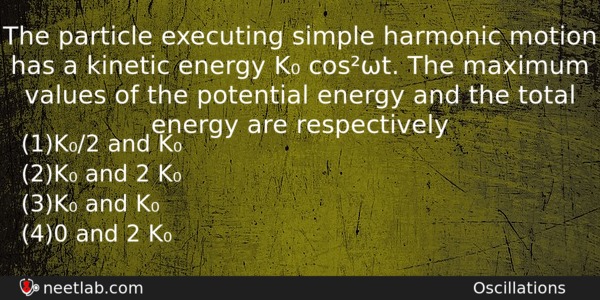| ⇦ | 
| ⇨ |
The particle executing simple harmonic motion has a kinetic energy K₀ cos²ωt. The maximum values of the potential energy and the total energy are respectively
Options
(a) K₀/2 and K₀
(b) K₀ and 2 K₀
(c) K₀ and K₀
(d) 0 and 2 K₀
Correct Answer:
K₀ and K₀
Explanation:
Kinetic energy + Potential energy = total energy
When kinetic energy is maximum, potential energy is zero and vice versa.
.·. Maximum potential energy = total energy
0 + K₀ = K₀
(K.E + P.E = Total energy) .
Related Questions: - A plane wave of wavelength 6250Å is incident normally on a slit of width 2×10⁻² cm.
- In an interference experiment, third bright fringe is obtained at a point
- The charges Q, +q, and +q are placed at the vartices of an equilateral
- Two straight wires each 10cm long are parallel to one another and seperated by 2 cm.
- Following figures show the arrangement of bar magnets in different configurations
Topics: Oscillations
(58)
Subject: Physics
(2479)
Important MCQs Based on Medical Entrance Examinations To Improve Your NEET Score
- A plane wave of wavelength 6250Å is incident normally on a slit of width 2×10⁻² cm.
- In an interference experiment, third bright fringe is obtained at a point
- The charges Q, +q, and +q are placed at the vartices of an equilateral
- Two straight wires each 10cm long are parallel to one another and seperated by 2 cm.
- Following figures show the arrangement of bar magnets in different configurations
Topics: Oscillations (58)
Subject: Physics (2479)
Important MCQs Based on Medical Entrance Examinations To Improve Your NEET Score
18000+ students are using NEETLab to improve their score. What about you?
Solve Previous Year MCQs, Mock Tests, Topicwise Practice Tests, Identify Weak Topics, Formula Flash cards and much more is available in NEETLab Android App to improve your NEET score.
Share this page with your friends

Leave a Reply